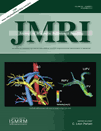Time-resolved dual-station calf–foot three-dimensional bolus chase MR angiography with fluoroscopic tracking†
The Supplementary Material referred to in this article can be found at http://www.interscience.wiley.com/jpages/1058-8388/suppmat
Abstract
Purpose:
To refine, adapt, and evaluate the technical aspects of fluoroscopic tracking for generating dual-station high-spatial-resolution MR angiograms of the calves and feet using a single injection of contrast material.
Materials and Methods:
Nine subjects (seven healthy volunteers followed by two patients) were imaged using a two-station calf–foot three-dimensional time-resolved bolus chase MR angiography protocol which provided <1.0 mm3 spatial resolution throughout and 2.5- and 6.6-s frame times at the calf and foot stations, respectively. Real-time reconstruction of calf station time frames allowed visually guided triggering of table advance to the foot station. The studies were independently read and scored by two radiologists in six image quality categories.
Results:
On average, overall diagnostic quality at the calf and foot stations was good-to-excellent, the calf arteries and all but the smallest foot arteries had good-to-excellent signal and sharpness, artifact and venous contamination were minor, and signal continuity across the inter-station interface was good.
Conclusion:
The feasibility of fluoroscopic tracking has been demonstrated as an efficient approach for high spatiotemporal imaging of the arteries of the calves and feet with good-to-excellent diagnostic quality and low degrading venous contamination. J. Magn. Reson. Imaging 2012;36:1168–1178. © 2012 Wiley Periodicals, Inc.




